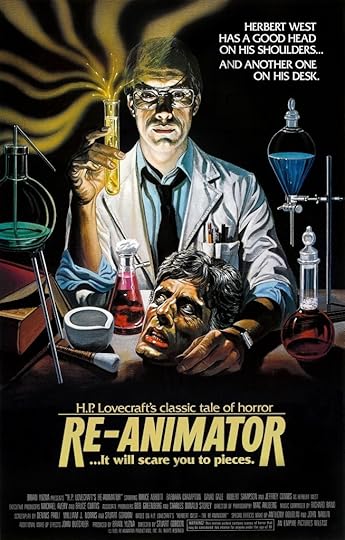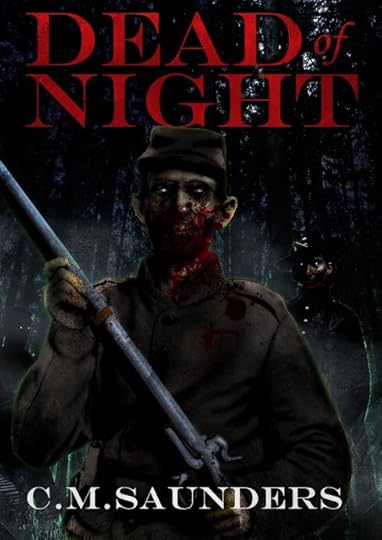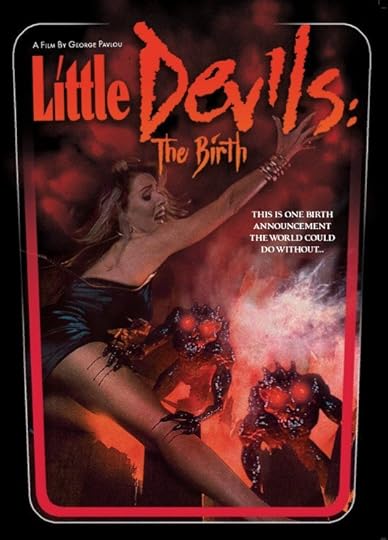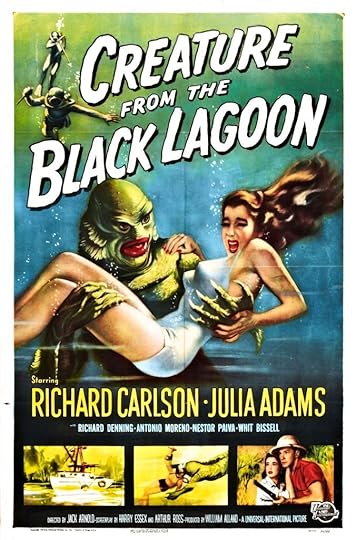C.M. Saunders's Blog, page 10
October 13, 2022
RetView #63 – Re-Animator (1985)
Title: Re-Animator
Year of Release: 1985
Director: Stuart Gordon
Length: 86 mins
Starring: Bruce Abbott, Barbara Crampton, David Gale, Robert Sampson, Jeffrey Combs
It’s been at least a couple of months now, so I think it’s about time we had another 80’s cheese fest. Re-Animator, aka H.P. Lovecraft’s Re-animator on account of being loosely based on Lovecraft’s 1922 work ‘Herbert West – Reanimator’ fits the bill perfectly. Directed by Stuart Abbott, who also directed From Beyond (1986), Dolls (1987) and wrote Honey I Shrunk the Kids (1989) and The Dentist (1995), it was originally intended to be a stage play, before given The Treatment, and that sense of intimacy has largely been preserved. With it’s a small cast, tightly-woven plot, and snappy dialogue, it’s easy to see why Re-Animator is now considered a bona fide cult classic. Shot in only 18 days, it is the first film in the Re-Animator series, and was followed by Bride of Re-Animator (1990) and Beyond Re-Animator (2003), neither of which hit the heights of the original.

After leaving his last place of education under something of a cloud, medical student called Herbert West (Combs) enrols at Miskatonic University in Arkham, Massachusetts (a fictional educational establishment in a fictional town in a real state), moves in with fellow student Dan Cain (Abbott), and then proceeds to turn the apartment into a laboratory. His experiments include killing and then re-animating Dan’s cat Rufus several times, much to the horror of Dan’s girlfriend, Megan (Crampton). Don’t worry, cat lovers, Rufus gets his own back. Dan tries to tell the Dean of the university (who happens to be Megan’s father) about West’s experiments but he is ridiculed, and the pair kicked out. They then hatch a plan to sneak into the morgue to use the reagent they have developed on a human subject to prove it works. It does, except the dead guy returns as a zombie-like crazed person. That’s when the Dean stumbles upon the scene, and shit gets really wild.
Producer Brian Yuzna (who played one of the hospital corpses, largely for his own amusement) described the film as having the “sort of shock sensibility of an Evil Dead with the production values of The Howling.” There are more than a few scenes to keep the gore hounds among you happy. My absolute favourite shows Dr Hill (Gale) in a role that the great Christopher Lee allegedly refused, removing skin from a corpse’s head on the way to extracting their brain, which he does with the words, “It’s very much like peeling a large orange.” According to IMDB, the special effects department went through 24-gallons of fake blood during the shoot, special-effects guru John Naulin said that Re-Animator was the bloodiest film he had ever worked on. In the past he had never used more than two gallons, which has to be some kind of compliment. Upon release, Re-Animator received an X (adults only) rating, and was later edited to obtain an R rating for video rental stores because some stores’ policies prohibited them from renting ‘unrated’ films with an MPAA rating of X. In the R-rated version, much of the gore was edited out and replaced with various scenes which had been deleted for pacing purposes, including a subplot involving Dr. Hill hypnotizing several characters to make them more suggestible to his will. A short scene was also added showing Herbert West injecting himself with small amounts of the reagent to stay awake and energized, which may have affected his thinking over the course of the film. On the other side of the pond, British Film Censors weren’t impressed with the scene where the severed head Dr. Hill attempts to rape Megan and refused to pass the film for release in the United Kingdom until the sequence had been cut. In Japan, the film is titled “ZOMBIO” though the title is dropped for the sequel because it translates as “Drifting Spirits” and makes no sense in the context of the film.
Re-Animator was received well, winning over many of the more arty critics. In her review for The New York Times, Janet Maslin wrote, “Re-Animator has a fast pace and a good deal of grisly vitality. It even has a sense of humor, albeit one that would be lost on 99.9 percent of any ordinary movie-going crowd.” In his review for the Los Angeles Times, Kevin Thomas said, “The big noise is Combs, a small, compact man of terrific intensity and concentration,” and David Edelstein, writing for Village Voice, an influential New York tabloid that closed in 2017, placed the film in his year-end Top Ten Movies list. In their book Lurker in the Lobby: A Guide to the Cinema of H. P. Lovecraft, Andrew Migliore and John Strysik write, “Re-Animator took First Prize at the Paris Festival of Fantasy, Science Fiction, and Horror, a Special Prize at the Cannes Film Festival, and even spawned a short-lived series of comic books. Even though it was a hit with audiences, the film generated a huge amount of controversy among Lovecraft readers. Fans thought the film a desecration of Lovecraft; their literary hero would never write such obvious exploitation!”
Trivia Corner
In December 1986, the year after Re-Animator was released, Barbara Crampton did a nude pictorial in Playboy magazine under the title, “Simply Beastly. Behind every successful monster, there’s a woman.” In an October 2020 interview with Entertainment Weekly, the then 61-year revealed that she was only given a second round of auditions for the role of Meg because the girl who won the part the first time around turned it down after her mother read the script and said “Oh, no. You’re not doing this.”
October 5, 2022
Gig review – The Dangerous Summer @ Thekla, Bristol, 29/09/2022
A year in China, Covid restrictions, and being old as fuck meant I hadn’t seen any live music for almost four years. That’s a long time, and it was always going to take something special to get me off my ass and down the front again. That ‘something special’ turned out to be a UK tour by The Dangerous Summer, one of my favourite bands of the past decade.

First, a word about the venue, Thekla. I love spaces with character, and being a converted cargo ship moored in Bristol’s Floating Harbour, Thekla has plenty of that. Built in Germany in 1958, it carried various cargoes between European ports until running aground off the coast of Northern England. And there it stayed, for seven years, until being bought, patched up, and sailed to Bristol by American novelist Ki Longfellow-Stanshall (who died earlier this year), her husband Vivian, and a small crew of volunteers, where it has played host to gigs, shows, and club nights since 1984. What a story.
TDS have to be one of the most underrated bands there is. I’ve been a fan since the Absolute Punk days (if you know, you know) and I reviewed both their 2019 album Mother Nature and their 2020 EP All That is Left of the Blue Sky right here on this blog. For all intents and purposes they are the definition of a cult band, and no doubt they’ll maintain that status long after they’ve gone. People will still be discovering them in 50 years time. Their fans know this. Musically, if you imagine a cross between Jimmy Eat World and Joshua Tree-era U2, with maybe a touch of My Chemical Romance or Alkaline Trio, you’d be half way there. Rather than try to make sense of my inadequate description it’s probably easier to just look them up on YouTube.
But first the support, Beauty School. I must admit I knew nothing about these guys. One of the joys of going to gigs, especially on the club circuit, is the opportunity to be blown away by bands you’d never heard of before. Granted, it doesn’t happen often, but when it does, it is a thing of beauty (school).
As I watched the Leeds-based five-piece plug in and tune up I must have looked like a curious spectator examining an especially interesting museum exhibit. They went about everything with gusto, and just seemed happy to be there. While most bands are preoccupied with image, one of these guys looked like Eddie the Eagle wearing a Leeds United shirt. I was curious to see what kind of noise a two-guitar set up would make, yet intensely wary of getting earfucked by a bunch of talentless northern reprobates. The tiny stage barely seemed big enough, especially when a man mountain with blue hair came bounding into sight holding a mic. I had barely finished asking myself who the fuck this might be when I realized it was the lead singer. Although a new band who have just released their first album, appropriately called Happiness, singer Joe Cabrera confessed mid-set that all the members were veterans of other bands and had presumably been on the circuit for years. This shines through in their playing, which is smooth, polished and full of energy. The highlight for me was Take it Slow and set closer Junior. They were so good I even forgave them for the Leeds United shirt.
I won’t waste time going over the history of a band with a lot of history. Let’s just say Maryland band TDS are out in support of their latest album, Coming Home. It’s been a long road. Soon after forming in 2006, they signed to Hopeless Records and put out a steady stream of quality material until 2013 when they took a 5-year hiatus. Since regrouping, you get the feeling they’re trying to make up for lost time. Long-time members AJ Perdomo (vocals and bass) and Matt Kennedy (guitars) have been supplemented by ex-Every Avenue guitarist Josh Withenshaw and demon drummer Christian Zawacki, who hits those things like a man possessed. The band’s entire chemistry is a thing to behold. They look like they’ve been playing together all their lives, and have no trouble replicating their studio sound in a live environment. If anything, the songs carry more weight, the musicianship even more impressively precise, and the lyrics even more impactful and emotive.
They start their set with Prologue from the aforementioned Mother Nature album, which isn’t a song at all but an intro fashioned from a genuine voice mail Perdomo received from a friend which became ‘It’s own piece of art’. This builds then segues effortlessly into Blind Ambition and the soaring title track from the new album, which judging by the reaction it received is already a crowd favourite. It can be tricky working new material into a set, but there were no such problems here. A lot of thought had gone into what was played when, and the newer material like Someday, which took its time to grow on me but now ranks in my top five, slotted in neatly with the more established crowd pleasers.
 I’m in this pic if you look closely
I’m in this pic if you look closelyWay Down was every bit as powerful as you might expect, the crowd noise regularly drowning out Perdomo’s vocals, and Where I Want to Be, the first track from their 2009 debut album, almost brought the house down. These are big songs, not just in stature, but scope and sheer presence. The only issue was the set having to be cut short because of an imminent club night, which smacks of either bad planning or simple greed, but was no fault of the band’s. They didn’t play my favourite song, either, but you can’t have everything. By the time we arrived at a euphoric closing one-two of Fuck Them All (which is nowhere near as aggressive as it sounds) and signature tune The Permanent Rain. I actually met a guy from Cardiff who said he’d named his own band after that song. There can be few greater compliments.
By the end of the set I felt like I’d been on a journey. I wasn’t quite the same person I’d been at the start. TDS have a back catalogue that puts most of their contemporaries to shame, and as they embark on this new chapter in their career having left Hopeless, gone indie, and then signed to Rude Records all in the space of a couple of years, they are destined to go from strength to strength. Don’t let them pass you by, or you’ll live to regret it. Come back soon, guys.
September 21, 2022
Dead of Night (Extract)
Greetings!
Just in time for Halloween, below is an extract from Dead of Night (Revised edition).
At some point, Nick dropped something, Maggie heard it hit the floor with a soft, hollow thud. She didn’t know what it could be, but guessed it must be pretty important because the moment it fell, Nick stopped in his tracks. They didn’t have time for this shit, they had to find cover. Now. It wasn’t safe outdoors, and Nick was fading fast. If he collapsed out here in the open, she would never be able to move him. They would be sitting targets for whatever prowled these fucking woods after dark.
She instinctively reached down to pick up the object Nick had dropped, then immediately put her hand to her mouth to stifle a scream. It was Nick’s severed hand. Pale now, almost translucent in the moonlight. It felt clammy to the touch. He’d carried it with him all the way from the camp.
It was still warm.
Dear God.
It doesn’t matter, she told herself. Pick it up and get going again. It’s just flesh and bone, just flesh and bone…
Grimacing, she tucked the bloodied appendage into the waistband of her sweatpants, took Nick by the remaining arm and resumed the journey.
Bizarrely, cruelly, in her fractured state, Maggie found that she couldn’t stop wondering how the hell they were going to carry the tent and all the rest of their stuff back to the car if Nick only had one hand. It would definitely be a struggle. They might have to make two trips, or even leave some stuff behind. She started mentally listing all the things they had taken with them, and then the things they could afford to leave behind. Anything to keep her mind working, keep it sharp and focused. If she stopped to think about the nightmare they were in, she would go to pieces.
Under normal circumstances it would only have taken a couple of minutes to get to the cabin, but in the dark and with Nick the way he was, it would probably take three times that long. At any moment she expected to see movement in the trees, or feel an arm reach out of the undergrowth and claw at her feet.
Things were going too well.
It was almost too easy.
But if she remembered correctly, Nick had put a tent peg straight into that thing’s eye. And didn’t it only have one eye to begin with? In that case it was probably still walking around in circles a mile or so away.
Maggie could feel exhaustion setting in. The muscles in her back and arms were screaming in protest from shouldering Nick’s extra weight and her second wind had come and gone. Probably her third and fourth winds too, if such things existed.
With grim determination, she pushed on. No time to stop, not here, not even for a second.
Finally, they arrived back at the cabin.
Dead of Night is available now on paperback and ebook.

Dead of Night is available now on ebook and paperback. If you’re interested in the book’s background and publishing history, check out this post I wrote about it.
September 13, 2022
RetView #62 – Little Devils: The Birth (1993)
Title: Little Devils: The Birth
Year of Release: 1993
Director: George Pavlou
Length: 100 mins
Starring: Russ Tamblyn, Marc Price, Nancy Valen, Wayne McNamara, Stella Stevens
Little Devils: The Birth is one of those films that got lost in the shuffle. Marketed as a comedy horror in the Gremlins or Ghoulies vein, it’s not really funny enough to be a comedy and not horrific enough to be a horror. It didn’t even have a hard rock soundtrack for Christ’s sake, and lacking big industry backing and a massive distribution deal, when it was released it fell between the cracks of the two genres and quickly became forgotten. In horror circles, just being aware of it granted you entry into some kind of exclusive club governed by knowing winks and secret handshakes. It doesn’t get more ‘cult movie’ than that.
It was reportedly conceived as a TV pilot for a new anthology series along the lines of The Hitchhiker and Tales from the Crypt, but when that plan fell through the makers decided to press on and turn it into a feature film instead. It received a timely boost when released by Shivers Entertainment on limited edition remastered DVD for the first time in 2017, but even then flew under the radar, the only media coverage being canned copy recycled from the press release churned out by bored journos with pages to fill. It’s almost as if there’s a conspiracy afoot to ensure the movie stays underground where it can build upon its growing reputation year on year until it eventually grows horns and takes over the world. I for one think it deserves a wider audience, so here we are.

Like all the best films, it begins when an unpopular, debt-ridden mad scientist. This one, Dr. Lionel (McNamara), literally goes to hell and back, and returns with a souvenir in the form of some runny mud that looks a lot like melted chocolate. Possessed and compelled to work, he sets about creating an army of tiny, impish figures who come to life, break out, and start terrorizing the apartment block in which he lives. First stop is the apartment downstairs which is home to Ed (Marc Price, of Trick or Treat fame – in which his character name was also Ed, weirdly enough) a frustrated writer reduced to producing smutty stories for a sleazy magazine to make ends meet whilst being pursued by strange, lust-filled landlord, Clara Madison (Stevens). Clara treats Dr. Lionel with complete disdain, yet has the hots for Ed. Ed isn’t interested, though. Especially after he meets exotic dancer Lynn (Valen) while researching a book at the local homeless shelter and the two begin a tumultuous relationship. Ed and his motley crew of friends, lovers and acquaintances then have to battle the rampaging horde of ‘little devils’ before things get (any more) out of hand.
Though very much a product of its time, given the pedigree of some of the people involved, it was something of a surprise that Little Devils: The Birth didn’t make a bigger splash. It was the brainchild of British director George Pavlou, who’d made his name on the Clive Barker vehicles Underworld (1985) and Rawhead Rex (1986), and writer Elliot Stein, fresh from the similarly-themed TV movie Gray Clay Dolls (1991). The biggest coup in front of the camera came in the form of the legendary Stella Stevens who had successfully made the transition from Playboy to the big (and small) screen, appearing in scores of movies and TV shows in a career spanning half a century including The Poseidon Adventure (1972), The Manitou (1978) and Monster in the Closet (1986). Despite the lowbrow, tongue-in-cheek subject material, her star quality shines through in every scene she’s in and its a bitter disappointment when *spoiler alert* the little devils get her half way through. In fact, all the actors do a decent job and the script, though played mostly for laughs, is also surprisingly good (sample dialogue: “You write porno. That doesn’t necessarily make you a pervert, even though you are one”).
Yes, the plot is silly, the effects are cheesy, and at times the whole thing feels a bit like one of those early Ratt videos MTV would play after midnight back when they still played music, but all things considered this forgotten gem is well worthy of its cult status. The title suggests that at least one sequel was planned, but that never transpired. Not yet, anyway. We can but hope.
Trivia Corner
Before becoming an actress, Stella Stevens was a member of the five-voice vocal ensemble The skip-Jacks who performed the theme song from The Flintstones, among other things. She went on to forge a long-term relationship with famed producer and one-time Kiss guitarist Bob Kulick, which lasted until his death in 2020.
August 23, 2022
Where’s my F***ing Sweatband?
I really like Dire Straits. You could say they are my guilty pleasure. I don’t think they are as respected or as widely known these days as they probably should be. Most of the people who do know them are left with that eighties caricature image of Mark Knopfler in the Money for Nothing video, wearing a jacket with shoulder pads and the sleeves rolled up, and a fucking neon headband. That’s more a representation of the eighties as a whole than the band.
The first DS record I ever bought was Brothers in Arms, which I sought out largely as a consequence of the copious amounts of TV advertising that went into promoting it. I mean, when it was £5.99 in Woolworths (which would probably amount to around £15 in ‘today’s money.’) you fucking knew about it. I only found out years later that most of the songs had been horribly edited down to fit on the vinyl.

Released over 35 years ago, Brothers in Arms, their fourth and most successful studio album, was a bit of a double-edged sword for Dire Straits. It was their Born in the USA. Actually, a lot of parallels can be drawn between Dire Straits (essentially singer/songwriter/lead guitarist Mark Knopfler with some other blokes) and The Boss, not least that both have working class roots and traded off the same kind of ‘everyman’ image. Of the two, Knopfler is without the doubt the better guitarist. He has a distinctive style, as do many of the greats from Jimmy Page to Brian May, in this case developed through ‘picking’ at the strings with his fingertips rather than using a plectrum. You wouldn’t even have to know the song to know who was playing guitar on it. On the flipside, The Boss is by far the better showman and probably the more consistent (and prolific) songwriter.
Another common denominator is that in effect, the Born in the USA and Brothers in Arms juggernauts alienated huge swathes of the respective artists’ existing audiences and attracted the ‘pop crowd.’ In the eighties, much like today, the Pop Crowd brought money, but no loyalty. They weren’t going to stick around. You’d be lucky to keep them interested for two albums, after that they’ll be into Fergal Sharkey or the Blow Monkeys for six months. The vast majority of bands don’t even get that two albums worth of grace.
It’s not enough to have talent and great songs. To attract the Pop Crowd and plug into the mainstream you need something else, some X Factor. In the case of Dire Straits, Brothers in Arms arrived within the eye of a perfect storm. It was released just as ground-breaking new tech was emerging in the form of CDs and CGI graphics, and MTV was just taking off. It soon became one of the bestselling albums of the era.
Dire Straits ended up paying a price for that success. By the time grunge hit a few years later they were typecast as a bunch of try-hard dad rockers and became a virtual laughing stock. Grunge, well, mostly Nirvana who spearheaded the whole thing, had a seismic effect on rock and metal. It almost killed off hair metal on its own, like a nuclear blast. Overnight, bands like Poison, Ratt, Cinderella, Motley Crue, Warrant, and approximately seven million others, all became irrelevant and then turned into shocked-looking parodies of themselves as they were reduced to playing 250-capacity rock clubs again instead of 20,000-capacity arenas they’d been used to. Def Leppard tried to fit in by recording Slang, for fuck’s sake. It was ugly.
Most of the artists who were left retreated into themselves. To use Springsteen as a yardstick again, he fired the E Street Band and released the limp one-two punch of Human Touch and the only-marginally better Lucky Town on the same day, just to try to stay relevant, and in 1991 Dire Straits put out On Every Street, their last studio offering. It’s not a bad album, just a bit tired-sounding in places. At best it was comfy and warm, at worst vapid and unrewarding. It was the sound of Dire Straits desperately trying to tread that middle ground between being true to themselves and pleasing their new legion of fans. The result was a big long sigh. Afterwards, the band fell into live archive releases and odd compilation territory and Mark Knopfler went solo.
Bloated and overlong, On Every Street was made for the CD market and it may be no accident that my top two Dire Straits studio albums, 1980’s Making Movies and 1982’s Love Over Gold would both fit on a single CD with room to spare. Although for the most part typically restrained (only Industrial Disease, Expresso Love and Solid Rock attempt to lift the mood a bit), those albums are focused and precise, a lot of the music dark and brooding yet filled with restrained passion. The musicianship is exemplary. I must have played those albums thousands of times. Earlier albums 1978’s self-titled and the following year’s Communique both had their moments, there were just fewer of them. Probably my favourite DS track of all time is Telegraph Road. At over 14-minutes long, it’s a stroke of genius. It takes a lot to keep me interested in anything for that long. I’ve had shorter relationships. I prefer the version found on Alchemy Live. I love the narrative, and how the song builds from little more than an understated whimper to a furious scream. Those power chords.
Alchemy, recorded at the Hammersmith Odeon in 1983 on the Love Over Gold tour, is pretty much the perfect live album if you can overlook the weak opening. Once Upon a time in the West to open a show when you have ready-made firecrackers like Tunnel of Love in your repertoire? Really?
Dire Straits are the consummate live band. But more the kind of band you’d like to see in a smoky club, or at a push, a theatre. They were a bit lost in those stadiums. the bigger the venue, the bigger the entourage and when you have a touring band numbering in double figures, it all gets a bit dramatic. If you’re interested, and you should be, there are also a few excellent bootleg recordings floating around. Koln ’79 is recommended (notable because they play Sultans of Swing twice having fucked the first one up), as is On Location – Live in Wiesbaden 1981 and Live in Sydney 1985. Recorded on the Brothers in Arms tour, that one is worth seeking out if only to hear the band wowing audiences at their commercial peak. For a while there, nowhere was safe from the Knopfler shoulder pads and sweatband.

If you enjoyed reading this, you might also enjoy my recent tribute to London Calling or one of my several Springsteen posts. I’ve also written about my personal musical odyssey and various other related shit.
August 13, 2022
RetView #61 – Creature from the Black Lagoon (1954)
Title: Creature from the Black Lagoon
Year of Release: 1954
Director: Jack Arnold
Length: 79 mins
Starring: Richard Carlson, Julie Adams, Richard Denning
There aren’t many movies that start with the big bang. Where can you go after that? In the first two minutes or so of Creature from the Black Lagoon we are treated not only to a massive explosion, but also a potted history of 15 million years of life on earth. And if that wasn’t enough, we end up tracking a team of explorers somewhere in the Amazon when they find a gigantic petrified claw which apparently belonged to some kind of amphibious creature they dub ‘Gill man’. In the wake of this discovery, the expedition shifts its focus to seeking out a live specimen, and then trying to escape when they realize the live specimen doesn’t much fancy a life in captivity and strikes back, a pivotal moment coming when the hunted becomes the hunter. It’s enough to make you dizzy. And that’s not even taking into account the fact that when this movie first hit cinemas, it did so in 3D. 1950’s technology was a far cry to what we have going on at the Cineplex these days, but let’s give them credit for trying. Upon release, the movie also broke several records for the amount of underwater filming it features, all of which is stunningly shot using a variety of (then) innovative techniques.

The story goes that producer William Alland was attending a dinner party during the filming of Orson Welles’ 1941 classic Citizen Kane (in which he played a reporter) when Mexican cinematographer Gabriel Figueroa told him about the myth of a race of half-fish, half-human creatures living in the Amazon River. Alland wrote some story notes using the imaginative working title The Sea Monster, which eventually morphed into Creature from the Black Lagoon years later. Just as he did on the Incredible Shrinking Man, director Jack Arnold does a masterful job. There’s a lot going on beneath the surface (sorry). First we have the simmering sexual tension between Kay (Adams) and her two male leads, who are both competing for her affections in vastly different ways. There’s David (Carlson) who dotes on her, in an old-fashioned, wrap-you-up-in-cotton-wool, slightly controlling way, while love rival and pantomime villain Mark (Denning), seems to take a more preening, misogynistic approach, parading around in his tight shorts whenever possible and being vocally resentful of Kay’s mere presence, which seems a bit counterproductive. Let’s not forget that this was an era when it wasn’t unusual to see leading men in movies wallop their woman about the chops if she dared step out of line. To be brutally honest, this pair of numb nuts make Gill-man seem like a real catch (sorry again). He’s also a bit creepy, by the way. Not only does he have scales, big bulbous eyes and massive clawed hands, but he likes to swim underneath Kay mirroring her movements whilst she unwittingly frolics about in the water. Tellingly, though, at the end when he finally kidnaps her, the creature doesn’t literally puts Kay on a pedestal.
In some quarters, the creature has become a metaphor for repressed sexual tension, which must have been rife in 1950’s America, what with the twin threats of communism and nuclear armageddon hanging over everyone. He is forever lurking insidiously behind the scenes, always threatening to break through to the surface and create havoc but never quite managing. The cultural impact of Creature from the Black lagoon has long been debated, the discourse summarized here.
The subtext is clear, but that doesn’t make it any less fascinating. It’s those pesky humans messing about with nature again. The poor amphibious creature and his relatives and cohorts had been quietly pottering about minding their own business in remote parts of the world for millennia. And quite possibly would’ve stayed there, too, had a bunch of selfish assholes not turned up and ruined everything. Shades of King Kong here, and even The Thing. The plot could even be a thinly-veiled attack on colonialism, or marauding white people in general. Watching it now, you can’t help rooting for the monster. In a contemporary article on Tor.com, Ryan Britt writes, “You never wanted them to kill that poor sea monster. In fact, you kind of wanted to see him take every single person on that boat out.” Adams herself later said, “There always is that feeling of compassion. I think maybe it touches something in ourselves, maybe the darker parts of ourselves, that long to be loved and think they really can’t ever be loved.”
Despite it’s modest beginnings, Creature from the Black Lagoon was a monster smash (That’s the last one, I promise) leading to two sequels, Revenge of the Creature (1955) and The Creature Walks Among Us (1956), and making an indelible mark on the movie-going public. Stephen King has said it was the first film he remembers watching. There has long been talk of a remake, mentioned in connection with such luminaries as John Landis, John Carpenter and Guillermo Del Toro, who credited the original for influencing his 2017 masterpiece The Shape of the Water, but it hasn’t surfaced yet (Okay, I lied).
Trivia Corner
After Universal had finished making the third and final film, a studio worker threw the creature’s costume in a dumpster, from where it was retrieved by a young man who repurposed it as a Halloween costume before selling it to Forrest J. Ackerman, a writer for Famous Monsters of Filmland Magazine.
August 6, 2022
Dead of Night – Reviews
When it was first released back in 2010, my splatterpunk novella Dead of Night picked up some pretty awesome reviews. I’ve gone back through my files and dug up some highlights. Loved the bitch slap at the end of the last review.
“In his zombie-infested novella Dead of Night, C. M. Saunders draws a picture of horror and desperation for his readers as he unleashes a band of undead Confederate bushwackers on an unsuspecting and innocent couple. As I read, I found myself pulled into the action, rooting for the young hero and heroine to make it through the night.”
“This story is not just hacking and slashing and eating brains; there is a fair share of suspense in Dead of Night that I found to be quite effective. Mr. Saunders gives his readers a chance to get to know the hero and heroine before plunging them into mortal danger, and this makes us care about their fate. Dead of Night contains a sense of urgency that will definitely get the blood pumping. Mr. Saunders brings us into the minds of his two protagonists; we share their terror, their pain, their despair, and their hope for survival.”
Book Wenches“Dead of Night is an obvious product of a great many horror films. The departure from realism, the horrendous injuries inflicted on the hero, the coincidences and lucky breaks â“ all lead directly from the late night horror screen. Evil Dead in particular seems to be a strong influence, especially with the besieged-in-a-cabin sequence.”
Dark Fire (UK)“Although it has lots of gore, it isn’t all about the blood and guts. Instead it is suspenseful and atmospheric. The scene where Nick wakes up in the middle of the night and first spots a zombie is tense. And being in the middle of nowhere, disconnected from the rest of the world with no one to turn to for help, added to the creepiness.”
“At the beginning, C.M. Saunders takes time to establish the characters, and although some may find that part slow, I found their relationship and discussion of Michael Jackson interesting. Since Nick and Maggie were well-developed I cared about them and found the story more interesting.”
Little Miss Zombie“If you are craving a zombie novel that deviates away from the typical “movie-style” theme – this will satiate your hunger. There are the normal horror elements: new love, remote setting, fight for survival, mass burial. However, C.M. Saunders’ Civil War zombies are intelligent; able to work as a team; possess fine motor skills; and cannot easily be killed. In fact, these “bushwhackers” peaked my curiosity. Would the psychological, mental, and physical aspects of fighting in a war end upon death? It is possible that these zombies are unaware that it is no longer 1861 – 1865. If this is the case, it would mean that they are denied the peace and solace they so richly deserve. The plot was very creatively written and flowed efficiently. I did not experience a single dull moment as I read the novel. Many of you will agree, a vast majority of horror novels have at least one character lacking a bit of common-sense. As others so eloquently state, “too stupid to live”. I feel that C.M. Saunders tried to weed the “stupidity factor” out, and he did a great job of it. The zombies were even spared this humility.”
Buyzombie.com“I have this horrible OCD quirk. It’s doesn’t matter how boring a story is, I have to finish it. Fortunately, that didn’t kick in with Saunder’s Dead of Night. This is a fun, short read that carries on with the latest trend of zombie soldiers. While Saunders doesn’t really bring any new to the table, it’s a cool chapter in the great big scheme of zombie stories. This is a great story. It’s a quick read with great cover art, and I do have to say, it’s MUCH better than Saunders’ first novella from Damnation Books.”
Swamp Dweller

Dead of Night (Revised edition) is available now on paperback and ebook.
July 23, 2022
X5 x 10 x 10
To mark the release of X5, my latest collection of short fiction, earlier this year I posted a line from one of the stories from it on consecutive days across my social media channels. Just for a laugh. As each of the X books contains 10 stories, that meant over the 10-day period I posted a total of 10 lines. I know that taken out of context they might not make much sense. The idea was just to give readers a deeper insight into each story than a standard synopsis would allow, and perhaps spark some morbid curiosity. Then I decided to collect all the extracts together here, because blogging.

“It looked like a giant moth/human hybrid, complete with a huge set of leathery wings folded behind it, and was covered in grey or black fur which had thinned in places to reveal skin so dry it resembled scales.”
“Its yellowing eyes were way out of proportion and had realigned themselves so they were on opposite sides of the head. The nose had elongated and extended into a snout, and the mouth was ringed by a pair of bulging, dark grey lips.”
“Their life force and vitality came from the blood of the vanquished, which they collected on the battlefield and doused themselves in or even drank, vampire-like.”
“Her head was full of abstract images offering a tantalizing glimpse of some other existence, a distant life full of meaning, colour and joy. But each day the images faded a little more and now she wasn’t even sure if what she saw were snatches of memory or some manufactured product of her fractured mind.”
“If I stay long enough, shivering in the doorway, mouth hanging open and facial muscles twitching, I see the stringy black stuff on the bathroom floor begin to take shape.”
“She couldn’t believe she was doing this. Picking up a hitcher? If dad found out he would kill her, if her passenger didn’t kill her first.”
“He couldn’t see them, but he could hear them panting and snarling.”
“When Sam was a child, he remembered thinking someone had been drawing on his grandad with a pen and spent hours trying to rub off the ‘ink’. Only later did he find out that the network of deep blue scars carved into his granite flesh were the result of a life spent on the coalfaces.”
“Something dark was smeared around his mouth, and I noticed he was holding something in his hands. Gradually, horrifyingly, the full implications of what I was seeing dawned on me.”
“The guy in a white coat asked if I was getting sexually aroused. Just came out and said it. I mean, what the fuck? Who in this world could or would get turned on by pictures of mutilated bodies and severed limbs?”
July 13, 2022
RetView #60 – Death Ship (1980)
Title: Death Ship
Year of Release: 1980
Director: Alvin Rakoff
Length: 85 mins
Starring: Richard Crenna, George Kennedy, Nick Mancuso, Sally Ann Howes, Kate Reid, Saul Rubinek
I’d never even heard of this Bloodstar Films production until I read about it in an issue of the venerated Fortean Times magazine (FT396, if you’re interested). I’ve always had a thing for Nazi zombies, as referenced before in previous RetViews Shock Waves and Outpost. I also recently discovered that I have a thing for horror set on ships. I have no idea why that is. It could be something about the bleak, all-encompassing emptiness of being at sea, but it’s probably more to do with the fact that if some supernatural shit befalls you in a house, or even a cabin buried in the woods, you can always just count your losses and run. You can’t do that on a ship. You have to stay and face whatever evil shit is about to befall you. Anyway, the potential for Nazi zombies and an evil sea-faring vessel combo suckered me right into Death Ship. Throw in Richard Crenna from the Rambo films, Saul Rubinek from True Romance (and Frasier) and George Kennedy from, er, Cool Hand Luke and Earthquake, I was already sold. And if all that wasn’t enough, just look at this poster!

So what’s it all about?
Well, stuffy Captain Ashland (Kennedy) is on his final cruise before handing over the reigns to Trevor Marshall (Crenna) who has brought his wife (Howes, in her final film appearance) and kids along on the trip. At a glitzy on-ship party there’s a band playing, some drunk people, and lots of terrible dad dancing. Everyone is having a great time. Except Captain Ashland, who you doubt could have a great time anywhere. But all the decadence and debauchery comes to a sudden halt when the cruise liner smashes into something and sinks, leaving just a handful of survivors unfortunately including Marshall’s annoying kids, a lecherous young officer, and a near-hysterical passenger, floating around on a makeshift raft. The next morning they find the grumpy captain in the water, which is a stroke of luck, or maybe not, then they come across a massive, ominous-looking black ship anchored in the middle of the ocean with a ladder down ready to receive them, which seems like another mad stroke of luck but turns out to be quite the opposite. Thinking they’ve found salvation, the survivors board the strange ship to find it deserted. Still, it’s better than being on the raft, or so they think. The first sign that something isn’t right comes when ship’s entertainer Jackie (Rubinek) is suddenly scooped up by a possessed winch and dumped screaming head first into the sea. Bye, Jackie. It was fun while it lasted. Things degenerate from there. The remaining survivors, whilst trying to navigate this mysterious vessel full of disembodied voices, creepy shadows and inanimate objects that take on lives of their own, get picked off one-by-one, until only the good-natured Trevor Marshall, his wife, and those annoying kids are left and ultimately find themselves back where they started on another flimsy-looking rafty-thing in the water. There’s probably a message there.
Life and soul of the party Captain Ashland and the underlying friction between him and his would-be replacement Marshall is instrumental in all this.
“You don’t know how to handle a crew or passengers!”
“Maybe so, Marshall. But I know how to handle ships.”
At one point, Ashland even dons a discarded German navy uniform and appears to channel the ship’s long-dead and rather sadistic head honcho whilst embarking on a murderous rampage. It all leads up to the highly anticipated revelation, which ties things up nicely and makes for a nice, satisfying conclusion. Especially after the evil Captain Ashland comes to a suitably sticky end and, of course, good triumphs over evil.
It’s easy to see why Death Ship got lost in the shuffle. It doesn’t have the immediacy of other popular horror flicks of the day like Cannibal Holocaust, Friday the 13th or Prom Night. It could, however, be a distant cousin of The Fog. It has a much more brooding atmosphere and, dare I say, slightly more substance reinforced by some remarkable cinematography, an impressive plot, and a killer (sorry) cast. It’s picked up a few retrospective reviews like this one on Warped Perspective, which is a real indicator as to whether a movie is truly attaining cult status, and review aggregate site Rotten Tomatoes gives it an overall score of 4.2 out of 10 based on 5 reviews, which isn’t as bad as it sounds. One review states, “Death Ship is a terrific, low-budget cheesy supernatural tale that should definitely appeal to midnight movie horror fans. I thoroughly enjoyed the film, and I feel that this is one of the most underrated films in the genre.”
It’s hard to argue with that, and those sentiments are echoed by Jeremy Blitz of DVD Talk, who said, “It isn’t a perfect film, but it is an enjoyable one, especially for fans of the somewhat lower tier horror efforts of the late seventies and early eighties.” Its flaws, however, are plain to see. Many called it unimaginative or derivative, with a shower scene in particular said to mirror the famous one in Psycho a little too closely. Incidentally, the shower scene in Death Ship was shot in one take, as it was deemed too expensive and troublesome to clean up the blood and shoot it again. It wasn’t all plain sailing (boom!). Damningly, TV Guide called the movie “ludicrous” and gave it a one-star rating. It’s probably safe to say that despite its considerable merits, this won’t be something that many of it’s stellar cast will look back on with much pride. For one delightful moment whilst researching this piece, I thought I’d stumbled across a modern(ish) remake. But that turned out to be nothing more than the result of some artwork someone mocked up in Deviant Art. Good effort, though.
Trivia Corner
As the ghost ship collided with the cruise liner, brief scenes of an explosion, a grand piano falling between decks, and the engine room flooding were cut in from another movie entirely. The movie in question was The Last Voyage (1960).
July 3, 2022
The Stigma of Self-Promotion

Self-promotion is a huge part of being a writer in the technological age. It’s even more important if you’re self-published, because then you’re completely alone. If you don’t sell books, nobody else is going to do it on your behalf. But even if you have work traditionally published, you can’t expect the publisher to shoulder all the expense and responsibility of shifting books in a crowded market place. Especially small-to-medium sized publishers with limited resources.
I’ve noticed that when they sell the rights to a book, a novella, or even a short story, some writers just move on instead of doing a bit of promo to help the publisher shift copies. Don’t do that. Every bit of attention you can generate helps, while simultaneously raising your own profile and giving you something to shout about. So tweet the link a few times, write a promo post for your blog, share it in a few Facebook groups, mention it on your Insta timeline, in short, tell all your friends. You might even choose to invest in some paid promotion, which I investigated in depth before.
A lot of writers maintain blogs, and a lot of writers struggle for things to blog about. Writing a promo post about an anthology or other market that has accepted one of your stories is an easy win. You can even use the cover art to illustrate it. Throw in a few comments about where the idea for your story came from and some buying links and you have the makings of a decent, informative, entertaining post to keep things ticking over. Just try to be creative with it. Inform or entertain, rather than just telling everyone you have a new book out. Make a few jokes at your own expense, or share a few extracts or obscure facts you maybe unearthed while researching the book or story.
If you’re worried about being seen as needy, don’t be. You’re a writer, and you’ve achieved something. Be proud. If nobody else ever gets to hear about your achievement, what was the point?
If this really is a deal breaker for you, try shifting the focus onto other writers instead.
So happy to be rubbing shoulders with Stephen King, Joe Hill, and Dean Koontz in this brand new anthology from This Massive Publisher!
As if that would ever happen. It would make that antho the literary equivalent of Woodstock. But trust me, any other writers you credit, not to mention the publisher, will love you for it. Even the stellar names. It’s a great way to kick-start some cross-promotion, where other writers in your genre chip in give you some mentions, or at least the book you both contributed to. There’s no better way to take advantage of overlapping readerships. Over and above all that, if the publisher sees you are willing to make an effort on the promotional front they just might look at any future submissions of yours slightly more favourably. It’s all about networking and forging mutually beneficial relationships, so don’t neglect your responsibilities and leave all the hard work to other people.



